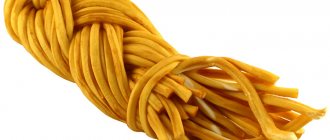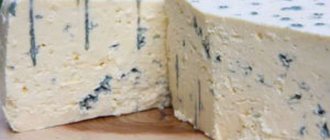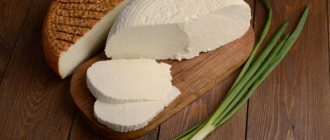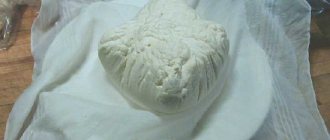Properties of brie cheese
How much does brie cheese cost (average price per 1 kg)?
The cheese of kings, the king of cheeses, the best of its kind - all this is usually said about the same product. We are talking about brie cheese, which is made from cow's milk. The product has French origins and a rich history. They have been making it for hundreds of years. During this time, the cheese did not disappoint anyone with its taste or aroma properties.
Many products are called the “King of Cheeses”. However, Brie has rightfully earned this title. It is considered the most famous French cheese. Only the best unpasteurized cow's milk is used in its preparation. The recipe itself is kept in the strictest confidence by each manufacturer.
Cheese wheels are made small - up to 5cm wide and 40-60cm in diameter. Young brie cheese has a pleasant soft creamy taste. Mature brie has a higher density, which makes the circle thinner. For its taste properties, brie is valued both among beginners and gourmets. It is ready to surprise you with its sharpness and piquantness. Add to this subtle notes of hazelnuts. It is not surprising that from the moment of its introduction, brie cheese was an integral element of the royal table.
It is noteworthy that only cheese produced in France can be called “brie”. This situation is regulated by special legislative norms. Despite this, the product is manufactured in Australia, the USA and some other countries around the world.
Edam cheese: calories per 100 g, proteins, fats, carbohydrates. Edam cheese, history and taste
Energy value (calorie content) of Edam cheese is 330 Kcal
per 100 grams of product (edible part).
The ratio of proteins, fats and carbohydrates: PropertyValue
| Calorie content, kcal | 330 |
| Proteins, g | 24 |
| Fats, gr | 26 |
Attractions
The most important and interesting sights of Edam.
Great Church
The Great Church or Grote Kerk is the main religious building of the city. Brick church in Gothic style, built between the 15th and 17th centuries.
Playing tower
The playing tower is a Gothic brick bell tower from the 14th-15th centuries. All that remains of the ancient Church of Our Lady of the 13th century, destroyed in 1882.
Nicholas Church
Nicholas Church is a neoclassical church from the mid-19th century.
Kwackelbrug
Kwackelbrug is a picturesque wooden drawbridge.
Old Town Hall
The Old Town Hall is a historic building dating from 1737 on Damplain Square. Nowadays there is a tourist information office here. Damplain is a 16th century square. In addition to the town hall, there is a neo-Renaissance building with a 19th-century tower, which formerly housed a post office.
Windmill Zuidpoldermolen
Zuidpoldermolen is a historical windmill from the 17th century.
Ingredients for making Edam cheese
- The technology for producing Edam cheese involves the use of cow's milk with a fat content of 1.6% to 3%. The fattier the milk, the fattier the cheese;
- 0.005 - 0.02% sodium nitrate and 0.015 - 0.02% calcium chloride;
- rennet extract;
- 1% bacteria for sourdough.
Product nutrients (details)
Chemical composition and nutritional value of Edam cheese Calories Vitamins Amino acids Minerals
Squirrels
Fats
Carbohydrates
Historical excursion
Edam has long been the hallmark of the Netherlands, because most of it is produced specifically for export. For the country itself, this cheese became the main component for prosperity back in the Middle Ages. Charles the Fifth once granted the opportunity to organize a cheese market every week. This tradition has been partially preserved to this day.
Edam made for the local population is coated with yellow wax; for export, red wax is used. True connoisseurs and connoisseurs of this product prefer aged varieties (from several months to a year and a half), coated with black wax. Imagine that edam production accounts for twenty-seven percent of the country's total cheese production.
We smear, cut, break
The cheese reveals its full flavor if it is removed from the refrigerator an hour before serving. It should be cut not into thin slices, but into small square cubes, and cheeses with a mold rind - so that the piece is small and has a crust not only on the top and bottom, but also on the side.
Hard cheeses, such as Parmesan, are not cut, but broken into pieces with a special knife. Fresh cheeses are either spread on crisps or bread, or cut into circles.
Slicers are ideal for slicing cheese. They will cope with this difficult task easily and quickly. The pieces will be exactly the thickness you need!
On the plate, different types of cheese should be arranged in order of increasing spiciness. The same rule applies when eating cheese. The fact is that if you first try cheese with a brighter taste, then later you will not feel all the variety and fullness of taste of soft and delicate cheeses.
Fruits and nuts are served along with the cheese: grapes and pears go perfectly with soft varieties, almonds and walnuts with fatty ones. The taste of blue cheese complements and softens the avocado.
Recipe for making Edam cheese at home
The ingredients you will need are sourdough and enzymes. It is better to buy milk in specialized dairy stores, where the quality of the product is beyond doubt. The key to delicious cheese is the freshness of the milk.
For the correct process you need to use special tools. These include food scales, mold, press, napkins, thermometer and initialed film. A mandatory rule is to do everything with clean hands or disposable gloves. The serum must not contain dust or foreign bodies. Any mistake and all the ingredients will be thrown away.
Detailed description of preparation.
- Heat pasteurized milk to 32 degrees. Next, calcium and leaven are added.
- Then the enzyme is added. Here you need to be careful with the portion, since most of the enzyme will taste bitter. After half an hour, you need to cut the resulting clot into several parts and leave it like that for 5 minutes. Small pieces indicate the hardness of the future product. For preparing soft varieties, large pieces or untouched pieces are suitable.
- Do not forget about stirring the mass, bringing it to 34 degrees.
- After this, excess whey is poured into the pan. On average it should be about 5 liters. Add hot water (about 50-60 degrees) and wait for the cheese mass to heat up to 70 degrees.
- Constant stirring continues. It is necessary to obtain a dense cheese mass. This will take about 30 minutes.
- Place the curd mixture in a colander and cover with gauze.
- A 5 kg weight is placed on top.
- Heat the serum to 48 degrees. Take out the cheese and place it in the heated milky liquid directly into the tissue. Pressed with a 15-kilogram press.
- Turn over and press with a 20 kg press. The duration of the procedure is 9 hours.
- Prepare a brine with the addition of whey and salt. Cheese is dipped into it.
- The product should dry in a cold place for about 4 days.
The next step will be aging the dairy product. Cheese requires a constant temperature of 14 degrees and a stable level of humidity - no less than 75 and no more than 85%. But if you covered the cheese ball with paraffin or placed it in a vacuum, you can ignore the humidity readings. Under the film cover, a special environment is created that is favorable for the ripening of the cheese product.
The minimum ripening period is 2 months. Longer aging gives the cheese a rich and pungent taste. Therefore, the aging period depends on your taste preferences.
By strictly following the recipe for preparing this type of Dutch cheese, you can surprise your family with a delicious and natural product of your own making. And you don’t have to worry about the quality of the product at all, since only fresh and natural ingredients were used in the preparation process.
Mineral composition
The ratio of minerals (macro- and microelements) contained in Edam cheese is presented in the table
using diagrams.
Rules for selection and storage
When choosing Edam, carefully examine the cut. First of all, there should be no seals around the edges - they are a sign that the rules for storing the product have been violated. The color of the cheese should be uniform - if light areas alternate with darker ones, this indicates that the cheese is not aged.
Please note that if you bend a slice of Edam, it should not break. Only minor crumbling is allowed.
Edam should be stored in the refrigerator, first wrapped in food parchment. Let us note that this type of cheese is considered “tenacious”; it does not spoil for a long time and does not lose its taste. That is why, from the 15th to the 18th centuries, Edam was invariably popular with travelers and sailors who took it on the road.
Chemical composition and energy value
It is noteworthy that there is no uniform production standard among Edam manufacturers, and the Edammer trademark itself is not protected. Therefore, the content of certain components in the product may vary. Traditionally, the calorie content of 100 g of cheese with 40% fat content is 300-315 kcal, and with 45% fat content this figure is 330-350 kcal.
100 g of Edam cheese contains 24 g of protein and 26 g of fat. There are no carbohydrates and dietary fiber.
Edam, like other types of cheese, is high in vitamins and minerals.
Vitamin composition (per 100 g of product)
| Vitamin PP (niacin) | 6.8 mg |
| Vitamin E | 0.4 mg, |
| Vitamin D (calciferols) | 0.86 mcg |
| Vitamin C | 0.7 mg |
| Vitamin B12 (cobalamin) | 1.4 mcg |
| Vitamin B9 (folic acid) | 19 mcg |
| Vitamin B6 (pyridoxine) | 0.1 mg |
| Vitamin B2 (riboflavin) | 0.38 mg |
| Vitamin B1 (thiamine) | 0.03 mg |
| Vitamin A (retinol) | 238 mcg |
| Beta carotene | 0.17 mg |
Mineral composition (per 100 g of product)
| Manganese | 0.1 mg |
| Copper | 70 mcg |
| Zinc | 4 mg |
| Iron | 0.7 mg |
| Sulfur | 263 mg |
| Phosphorus | 600 mg |
| Potassium | 100 mg |
| Sodium | 1100 mg |
| Magnesium | 55 mg |
| Calcium | 1000 mg |
What does milk give to cheese?
To produce one kilogram of cheese, you need about ten liters of milk - cow, sheep, goat or buffalo. But there are other options.
Thus, Finnish cheese Ilves is made from reindeer milk, and in Jordan, to make laban, shepherds take goat, sheep and camel milk along with cow's milk. Sweden produces a unique cheese from moose milk.
Its price is $1000 per kilogram. In addition to the type of milk, the habitat of the animals plays an important role. For example, mountain cheese is made only from the milk of Alpine cows.
Interestingly, there is no generally accepted world classification of cheeses. Although the French tried to make one, experts recognize its convention: there are varieties of cheese that are difficult to classify as any type.
In everyday life, cheeses are usually divided according to consistency - hard, soft and processed. Hard cheeses are the most popular and beloved in Russia. They can be boiled or uncooked. The first ones have a light crust, pale yellow color and “eyes”.
The taste of the product is affected by the time of year - cheeses made from summer milk are much more aromatic, while cheeses made from winter milk are milder in taste. Popular varieties include Emmental, Parmesan, Gruyère, Comté, Beaufort, and Swiss.
Uncooked cheeses can be recognized by their hard crust, dense but delicate consistency. During preparation, the cheese is processed in brine and matured in large perforated molds.
From time to time the cheese is salted, turned over and brushed. The most famous varieties: edamer, gouda, cheddar, cantal, pecorino, reblochon, mimlette.
Soft cheeses are still rare guests on Russian tables due to their lack of popularity and high cost.
The taste of brie and camembert cheeses with noble white mold (during the manufacturing process they are sprayed with a solution of a special fungus and kept in the cellar for 2-6 weeks) has always been highly valued by the French nobility. Brie, for example, is considered a first-class dessert.
Blue cheeses are made from uncooked and unpressed cheese, which is rubbed with salt and pierced with long needles containing mold fungi, which promotes the development of blue-green veins inside the cheese. Gourmets love Roquefort, Gorgonzola, Danablue, Fourme d'Ambert, and Bleu d'Auvergne.
Source: https://pro-acne.ru/pohudenie/syr-edam-kalorijnost-na-100-gramm-330-kkal.html
Brie cheese reviews and comments
Kaliostre
14.11.2014
Fiction (one might say communist propaganda) - cheese does not exist! It once existed in the old Soviet times, but now who would use such time-consuming and expensive methods, fat content - add trans fats, taste - flavoring additives, and everything will be excellent (harmful!). Of course, I’m exaggerating, but all this is very close to the truth. It’s not for nothing that in recent years I’ve only been using Valio oil (it has a good reputation - although it’s impossible to find it now due to regulations, and for example, the French President doesn’t even come close to the oil, although it seems to be in Europe!). But after all, butter is much easier to make than cheese, and anyway, the notorious trans fats banned by WHO are used. But what a gain. And our life is priceless, in the sense of a “tin can”, so why not ruin it!
Which cheese is good for weight loss? Calorie content of cheese varieties
Cheese is a favorite product for many and a valuable addition to the daily diet. There are a huge number of varieties and types of this delicacy, some of which can be included in the weight loss menu.
In order not to deny yourself the pleasure of enjoying a couple of pieces of cheese while continuing to lose weight, you need to know which varieties are acceptable to eat during a diet and will help you lose extra pounds.
Composition and beneficial properties of cheese
This product, regardless of variety, contains:
- provitamin A, vitamins E, D, C, PP and group B;
- amino acids not produced in the human body (lysine, methionine and others);
- easily digestible protein;
- micro- and macroelements.
It contains especially a lot of calcium, which is necessary for bone tissue and tooth enamel. The vitamins present in cheese normalize the activity of the central nervous system and participate in the process of hematopoiesis.
The dairy treat helps improve digestion. It is recommended to be consumed as a dessert after a meal. It helps restore metabolic processes, which is especially important for those who want to lose weight and suffer from impaired metabolic rate.
Cheese for weight loss
The average energy value of the product is about 340-370 kilocalories per 100 grams, due to the ratio of milk, starter and rennet. Calorie content did not cause it to be included in the list of foods prohibited for consumption when losing weight.
This is due to the high nutritional value of this dairy product. Eating cheese in small quantities gives you a feeling of fullness and allows you to receive all the substances necessary to maintain normal life.
There are diets for weight loss that involve eating cheese. This is great news for those who cannot do without this product. This is especially true for vegetarians. Giving up meat requires finding an alternative source of protein, which is cheese.
Post Cashew nuts - benefits and harm
It should be remembered that not all cheeses are equally useful for losing weight.
This is due not only to calorie content, but also to production technology, which may involve the inclusion of various additives in the product.
And in order not to harm your figure, you need to know not only the energy value of different varieties, but also the criteria by which to choose this product.
How many calories are in different types of cheese?
The calorie content of a dairy product is due to the predominance of fats over other macronutrients - proteins and carbohydrates. Cheeses with 50% fat content contain from 360 to 380, and 45% - from 300 to 350 kilocalories.
| Name | Kcal per 100 grams |
| Creamy | 439 |
| Cheddar | 412 |
| Lambert | 377 |
| Sheep | 370 |
| Dutch and Russian | 360 |
| Roquefort | 352 |
| Swiss | 335 |
| Parmesan | 330-389 |
| Bree | 319 |
| Fused | 305 |
Tables cannot fully reflect the energy value of cheese. It depends on the technology and recipe used to produce the dairy product.
Six cheeses for dietary nutrition
The cheeses listed above, from cream to brie, are quite high in calories and are not entirely suitable for those who care about their figure or are on a diet. The best for weight loss are:
- Mozzarella. Its calorie content varies from 160 to 350 kcal. The product made from skim milk has the lowest calorie content. This cheese is easily digestible and even in small quantities can add a unique taste to any dish.
- Adyghe. It has an energy value of no more than 240 kcal. Excellent for preparing vegetable salads, canapés with whole grain bread - dishes that are ideal as dietary dishes. It contains a lot of salt. People prone to swelling are recommended to use it in the first half of the day.
- Feta . One hundred grams of this cheese contains no more than 260 kilocalories. It is practically devoid of carbohydrates, and fats are only partially absorbed from it. Thanks to its original taste, reminiscent of feta cheese, it will be an excellent addition to salads.
- Farmer's. Very similar to the Adyghe one, but not so salty, it can be an excellent replacement for it. This cheese contains approximately 207 kcal. It is used both as an addition to cold appetizers and in the preparation of hot dishes.
- Ricotta. It is prepared not from milk, but from whey. This explains its low calorie content, equal to 174 kilocalories, which does not in any way affect its value for the body. Its main feature is the quick feeling of fullness that a person feels after eating a small amount of ricotta.
- Tofu. A unique product made from soy milk. Due to its plant origin, it contains no more than 90-100 kcal. It is highly valued in cooking because it can be used for absolutely any dish, including desserts.
Entry: Dairy products for weight loss. What can you eat if you are losing weight?
There are two more types of cheese, which according to some sources are recommended for inclusion in the diet menu - Camembert and Chechil. The first should be used only by those who keep themselves in shape and are not overweight. The second, having a fat content of 5 to 10%, is very salty and can provoke an increase in appetite.
Which cheese should you choose for your diet menu?
Those who want to lose weight with health benefits need to be careful when choosing cheese. Along with calorie content, you should pay attention to the following points:
- Compound . The modern food industry does not always follow the traditional recipe, including various preservatives and phosphate additives in the composition of the dairy product. They should not be in healthy cheese.
- Fat content. Preference should be given only to low-fat and low-fat types. The same type of cheese may have a higher or lower energy value. The difference sometimes reaches up to 100-200 kilocalories.
- Sugar and flavorings. These components must be absent from the composition. This mainly applies to processed cheese.
It matters not only what kind of cheese is chosen, but also how the product is consumed. People suffering from lactose intolerance can only eat tofu.
How to eat cheese for weight loss?
You should not overuse cheese, especially with a high salt content. Suluguni, feta cheese, and Adyghe cheese can be soaked in water before consumption and eaten only in the first half of the day.
The only cheese that can be eaten without restrictions is tofu. Even a kilogram of low-fat mozzarella or ricotta contains a lot of calories. The optimal daily intake is considered to be from 100 to 200 grams of low-fat cheese.
Diet with processed cheese
Great for people who find it difficult to tolerate strict restrictions. It assumes a monotonous menu consisting of:
- unsweetened tea and processed cheese for breakfast;
- eggs, greens, tomatoes for lunch;
- apples for afternoon snack;
- 250 grams of low-fat cottage cheese, vegetable salad for dinner.
Post Methods of using mushrooms for weight loss
You can follow this diet from 5 to 10 days a month to lose 3-5 kilograms.
Summarizing
Cheese is a healthy product that, when consumed in moderation, will be an excellent aid in losing weight. It allows you to get all the necessary nutrients, gives a piquant taste to dishes, which makes it easy to endure deprivations as part of your diet.
Source: https://zhenskietainy.ru/pohudenie/pravilnoe-pitanie/kakoj-syr-podhodit-dlya-pohudeniya-kalorijnost-sortov-syra
Useful properties and calorie content
Brie cheese contains many useful amino acids, protein, vitamins A, B and D. Like many dairy products, it contains such important elements as calcium, phosphorus and magnesium. But oddly enough, Brie contains extremely little lactose, which makes it available for consumption in small quantities by people with lactose intolerance.
Despite all the advantages of the French delicacy, you should not get too carried away with this product due to its high fat content.
100 grams of brie cheese contains approximately:
- 330 calories
- 19 grams protein (76 kcal)
- 26 grams fat (234 cal)
- 0.4 grams carbohydrates (0 cal)
Energy ratio of proteins, fats and carbohydrates: 23%/70%/0%
Everything is good in moderation
The relatively low calorie content of brie cheese is not enough to limit yourself to one piece for the whole day. However, increasing the dose does not cover energy costs; on the contrary, it increases the load on the body.
The penicillin mycelium contained in noble mold is dangerous for people who cannot tolerate these antibiotics. Eating a small amount of mold cheese can trigger an allergic reaction.
For people suffering from dysbacteriosis, blue cheese is also contraindicated. Additional intake of an antibiotic, even its predecessor, aggravates the course of the disease. The normal intestinal microflora dies, and opportunistic bacteria multiply due to active division. However, dysbiosis is a temporary condition. After its treatment, contraindications for eating mold cheese are removed.
Delicious soft brie cheese is recommended for people exposed to sunlight: on beaches. Accelerated production of melatonin protects the skin from sunburn. The person rests, the tan spreads evenly, the mood remains elevated, because something as small as eating brie cheese solves the problem of purchasing sunscreen and the consequences of sunburn. At the same time, excessive consumption of blue cheese leads to intestinal disorders due to exposure to noble mold, which contains a precursor to penicillin.








